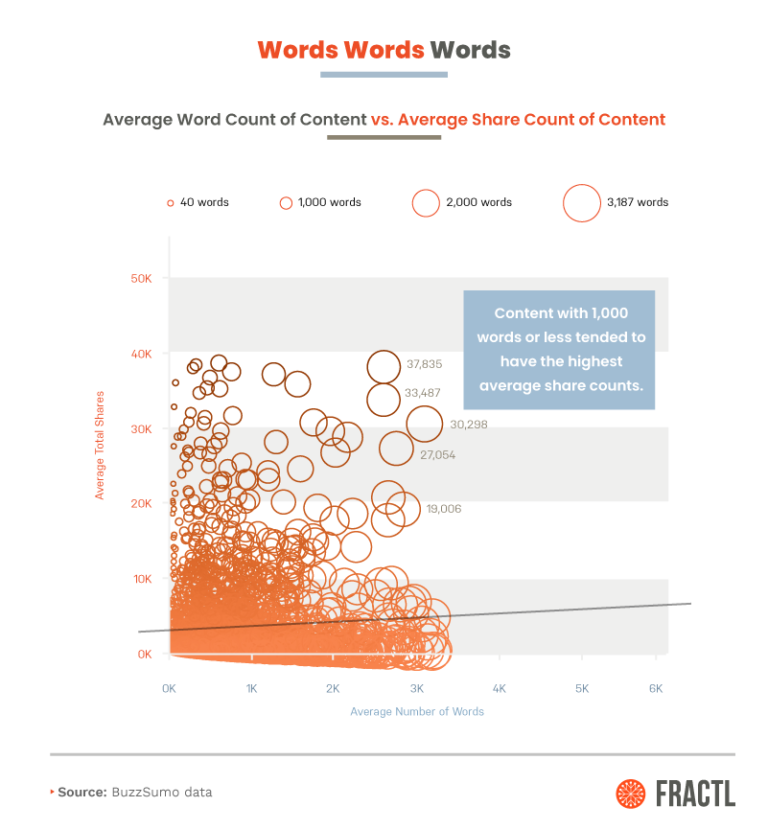Shorter content earns the most backlinks, on average, according to an analysis of thousands of articles.
Fractl analyzed over 5,000 articles to find the most linked-to articles are roughly 695 words in length.
The study includes further analysis of content length, as well as insights on:
- Most shared articles
- Most linked-to articles
- Evergreen vs. timely content
Here are some key takeaways from the study.
Linkability and Shareability of Articles
This study examines the share count and backlink count of articles to identify what marketers can learn from content that earns the most shares and links.
“The goal was to identify qualities of content that has also managed to be deserving of links so we can reveal ways to optimize content for link building.”
In conducting the study, only articles with at least 25 backlinks were included.
Fractl also avoided studying content from major news sites in order to make its findings more relatable to marketers.
With that out of the way, let’s dive into the data.
Evergreen Content vs. Timely Content
An article is considered evergreen if it can maintain relevance for an extended period of time.
An “evergreen score” (a BuzzSumo metric) is assigned to articles based on the number of social engagements and backlinks an article receives after being published for 30 days.
The more engagements and social media activity, the higher the score.
The overall of evergreen score of all articles studied is 5.5 out of 30.
This immediately suggests timely content can earn many links:
“… this still points to a trend that perhaps content that taps into timely topics can get a lot of links if it’s original and interesting enough.”
How-to articles were found to be the most evergreen of all article types.
Most Shared Content
The study analyzes the share count of articles to find the average number of shares by vertical and by article type.
These are the average number of shares by vertical:
- Sports (5,202)
- Sex and relationships (4,610)
- Fitness (4,587)
- Health (3,883)
- Technology (2,996)
- Travel (2,928)
- Food and drink (2,878)
- Finance (2,018)
These are the top five content types according to number of shares:
- How-to article (14,475)
- List/video (10,251)
- How-to article w/ video (8,623)
- List/infographic (7,260)
- Newsletter (4,914)
Lastly, here are the top 5 most shared article types for each vertical.

“Probably the most actionable pieces here are the content types that are most shared, especially seeing them by vertical. It’s worth checking your editorial calendar to see if you’re featuring enough of these types of content.”
Content with 1,000 words or less tend to have the highest average share counts.
However, many articles with a high word count receive a large number of shares as well, as you can see in this graph.

This doesn’t necessarily mean that marketers should aim for a particular word count in order to get more shares.
As Fractl states, word count should depend on the article topic and who you’re writing for.
“When it comes to word count, this just emphasizes that it depends on the topic and why you’re creating the content; the length should correspond to the reader’s intent. Do they want a quick answer or a conceptual deep-dive?”
Most Linked-to Content
An analysis of “high rollers,” or content with at least 50 backlinks, identifies which article types are the most linked-to.
Here are the top 5 article types based on number of backlinks achieved:
- How-to article
- General article
- List/general article
- Newsletter
- Video
These trends are not too dissimilar from the most-shared content types.
Emotional Reactions to Linked-to Content
The study examines the emotional response to content based on Facebook reactions.
According to the findings, there seems to be much anger on Facebook as the angry reaction is the most used overall.
Here’s a look at different content verticals and the type of emotional response that’s most triggered by each of them.
- Sports (sad reaction)
- Sex and relationships (angry reaction)
- Fitness (wow reaction)
- Health (love reaction)
- Technology (angry reaction)
- Travel (love reaction)
- Food and drink (sad reaction)
- Finance (angry reaction)
With these results in mind, it may be beneficial to create content that taps into a particular emotion depending on the vertical you’re writing for.
For example, when writing about travel or health, content may be more successful if it triggers a love reaction.
Articles about fitness may be more successful if they can make the reader say “wow.”
And so on.
In Summary
Fractl sums up its study with the following takeaways. The keys to creating content that earns links and shares is to:
- Meet the user intent
- Tap into emotions that resonate with your vertical
- Keep it straightforward
- Don’t underestimate the impact of how-to content
For more insights see the full study here.





![AI Overviews: We Reverse-Engineered Them So You Don't Have To [+ What You Need To Do Next]](https://www.searchenginejournal.com/wp-content/uploads/2025/04/sidebar1x-455.png)